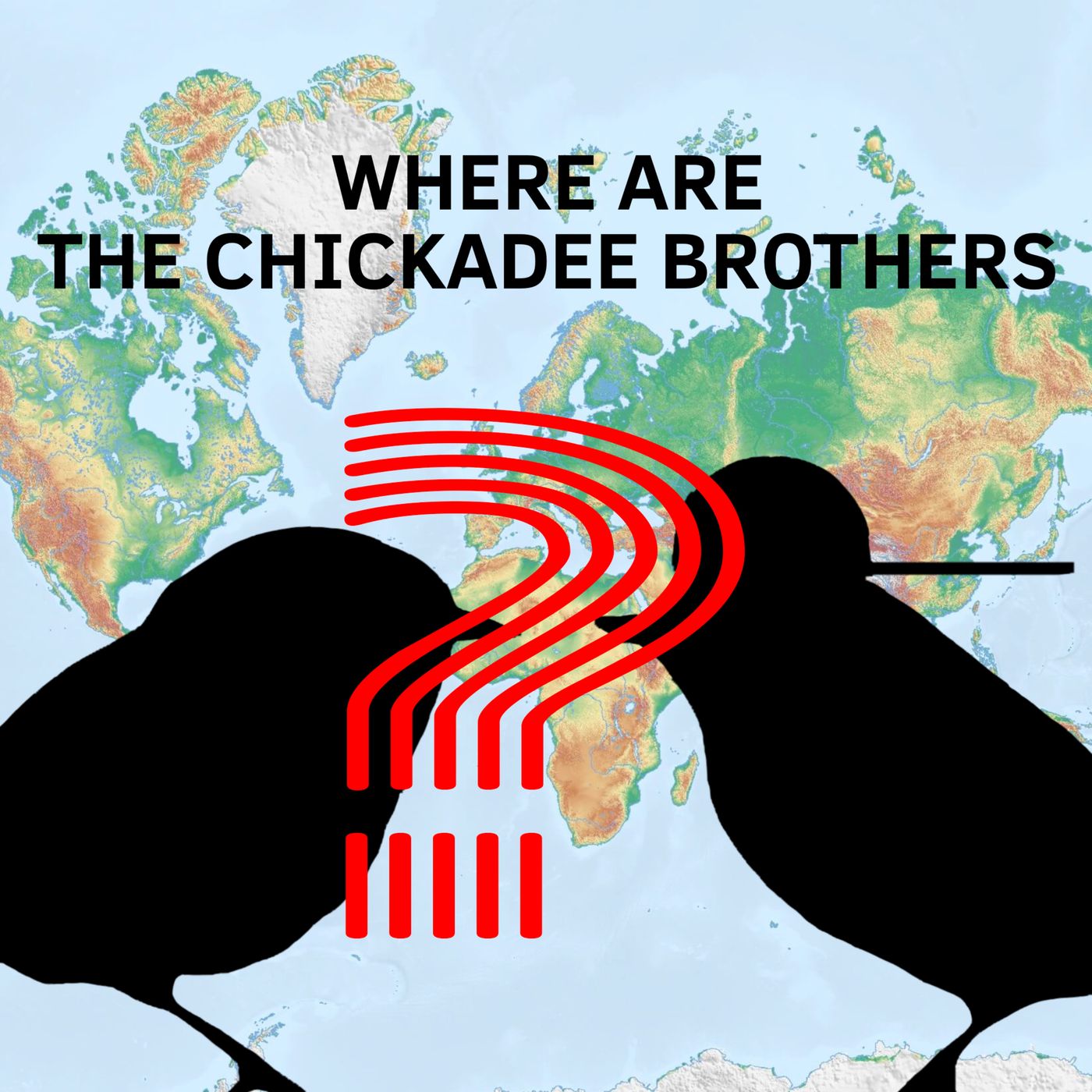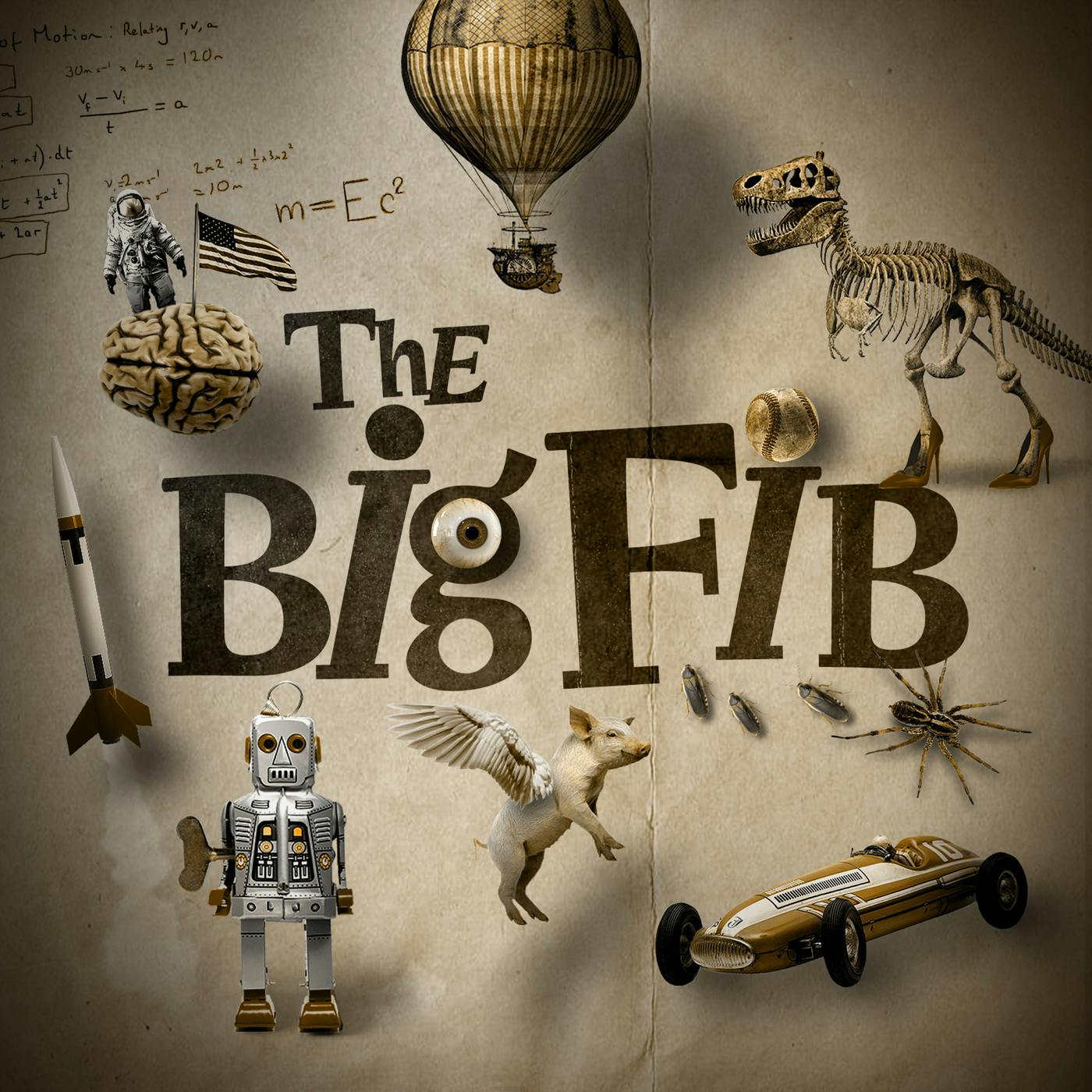
Kingdom: Animalia - A Zoology Podcast for Kids
This is a for-kids-(and adults)-by-kids-(and chickadees) animal podcast. In every regular episode, your host, Devon, and podcast-overthrowal-plotting chickadee co-hosts, Chet and Cap, will dive into all the facts about one species of animal with jokes, fun facts, and quizzes along the way. Every third-ish episode is our game show, Animalia Fake!, in which there are three rounds with four outrageous animal facts; one of those facts is so outrageous it’s an Animalia Fake (it’s not true), and you have to guess which it is.
You can send in questions and episode suggestions to animals@kapods.org, and my website is https://kapods.org/animals. So what are you waiting for? Let’s explore this amazing Kingdom: Animalia.
New episodes every 1–2 months.
Kingdom: Animalia - A Zoology Podcast for Kids
Orchid Mantis
Oh, look at that pretty flower! Wait a second…
______________________
Are they a flower, or are they an insect? Orchids are pink and white,… and some mantises are too? Do female mantises eat their valentine? Exactly how fast can a mantis strike? Do baby mantises have the zoomies? Mantises have only two eyes… right? Today with your host, Devon, and co-hosts, Chet and Cap, you will learn everything there is to know about the Orchid Mantis, Hymenopus coronatus.
Links:
Credits:
- Additional Music: Kevin MacLeod
If you have any questions, comments, episode suggestions, or verification that I’m not just talking into the void, please send them in (links below)! It really means a lot. Also, if you like this podcast, please share it with someone else who might!
Get in Touch: animals@kapods.org or kapods.org/contact
Visit My Website: kapods.org/animals
Follow in Your Favorite App: kapods.org/animals/follow
**Psst! Hey, you! It’s Chet and Cap! Do you have any questions for us? Just head over to kapods.org/acb and send a voice message or email with your questions, and we’ll answer them on an Ask the Chickadee Brothers episode of this podcast!**
Until next time, keep exploring this amazing Kingdom: Animalia.
This podcast is made by Kingdom: Animalia Podcasts.
[Devon] Hello podcast listeners! Welcome to episode five of Kingdom: Animalia - A Zoology Podcast for Kids. Happy almost Valentine’s Day to those who celebrate! [Chet] Chicka I love Chicka the imitation Chicka chocolate covered Chicka birdseed! (Chicka Because birds Chicka can’t eat Chicka chocolate.) [Devon] I think there’s a little more to it than that. [Chet] Chicka Agree to Chicka disagree. [Devon] Okay Chet. So, in case you forgot, or are just beginning to listen to the show, I’m your host, Devon, and these are my co-hosts,… [Cap] Chicka Cap… [Chet] Chicka …and Chet! [Devon] Today, on the fifth episode of Kingdom: Animalia - A Zoology Podcast for Kids, we’re learning about the Orchid Mantis, Hymenopus coronatus; which you’ll soon find out may be one of the worst valentines. Enjoy.
[Devon] Like most mantises (which actually make up an entire order, and fun fact: whose closest relatives are cockroaches) they have long and flexible necks and a triangular head. Like all insects, they have six legs, and like all mantises their frontmost pair of legs is highly developed, muscular (as much as an insect leg can be considered muscular), and covered in spines on the bottom like a serrated steak knife. These special forelimbs are designed for grabbing their– [Cap] Chicka Caps! [Devon] *Sigh* No Cap. Designed for grabbing their prey, and are not used for walking. These legs are called their, A), grabber legs, B), arms, C), raptorial forelegs, or D), praying forelegs? Chet? [Chet] Chicka C! [Devon] Cap? [Cap] Chicka C! [Devon] Alright. Give me a drumroll please Chet… [Chet] Chicka Your prayers Chicka shall be Chicka answered. [Devon] The answer is… C! You’re both right! [Chet] Chicka Yay! [Cap] Chicka Woohoo! Chicka Thank you. [Chet] Chicka Thank you! Chicka Who are Chicka the chickadees? Chicka We are! Chicka I’d like Chicka to thank Chicka my agent, Chicka my teacher, Chicka my… [Devon] I think that’s enough Chet. [Devon] Okay. They’re called their Raptorial forelegs, raptorial meaning to grab or to seize. Their other four legs (four as in the number four) are for walking. This walking with all but two limbs gives them an upright stance. Despite different uses, all six of their legs resemble– [Chet] Chicka Birdseed! [Devon] No Chet, they resemble FLOWER PETALS. The upper parts of their walking legs are flattened into large ovals, and their raptorial forelegs are lobbed and slightly flattened uniformly. The flattened nature of their legs makes them look uncannily like flowers. Like most mantis species, the females are larger than the males. The females at two point three to two point seven inches or five point eight to six point eight centimeters long are roughly forty five percent larger than their male counterparts who are only zero point seven to one point one inches or one point seven seven to two point eight centimeters long! This is called sexual dimorphism in which one gender of a species is larger or more flamboyant than the other. On top of that the females are larger than the males, today’s species is debatably the prettiest species we’ve talked about on this show. Shunning the somewhat drab brown and green of most mantises, the Orchid Mantis is beautifully dressed in a splendid white and pink exoskeleton, but can also take on a brownish hue depending on their background. Their exoskeleton is mostly white with pink and/or yellow to orange accents. Somewhat like a slow chameleon, the Orchid mantis can change their coloration between pink, purple, and brown over the course of a few days. The male Orchid Mantises on the other hand (or the other raptorial forelimb), are drab and yellow-green with brown markings twenty-four seven.
[Devon] And now let’s address the mantis in the room: Why isn’t Devon giving Cap infinite caps?… Wait what? [Cap] Chicka Yeah, Devon. Chicka Why aren’t Chicka you? [Devon] *sighs as speaks* Cap, did you change my script, Cap? [Cap] Chicka Of course Chicka not… *voice get progressively higher* Chicka Why would Chicka I? [Devon] You’re not a very good liar, Cap. Your voice always gets really high. [Cap] Chicka *Groan* [Devon] Okay. I’m going to go and replace my script. I’ll be back right after the theme music.
[Devon] Okay. I’m back with an un-tampered-with script. Here we go. And now let’s address the mantis in the room: Why do these insects look the way they do — like a flower? We’re going to answer this question in a new segment I call: Animal Investigations
[Cap] Chicka Option Number Chicka One: Chicka To attract Chicka a mate? [Devon] Some animals evolved to have pretty colors to attract a mate. Is this the case with Orchid Mantises? Short answer: No. In animals it is typically either the male or both the male and female who do the attracting of mates. But it is only the female who is pretty and they don’t seem to be trying to attract the males. So Option Number One… is a no go.
[Cap] Chicka Option Number Chicka Two: Chicka To Camouflage? [Devon] Many organisms resemble their environment to hide from predators and/or their prey. This is called cryptic mimicry. This has long been thought to be the case with Orchid Mantis, but is it really? Short answer: No. There are two reasons: The first brings us back to the last option. The males and females are differently colored. They live in the same environment, so if it was to camouflage, why would they be differently colored? So Option Number Two… is a no go.
[Cap] Chicka Option Number Chicka Three: Chicka To attract Chicka prey? [Devon] This is where a predatory organism evolves to attract their prey to them. This is called aggressive mimicry. Is this the case with Orchid Mantises? Short answer: Yes. There was more proof against Option Number Two. When the female mantis was placed next to a common flower in their habitat, the insect prey would actively approach the mantis, and not the flower. This showed the mantises were actually attracting the prey to them, and not making them oblivious to their presents. The coloration of female Orchid Mantises tells the brains of their insect prey items “There’s delicious nectar here”, causing them to approach and get captured. The reason the males don’t do this is simple. The males actually do Option Number Two, they camouflage to hide from predators and capture their prey like other mantises in which they resemble with their drab green coloration. However, the females are larger and live longer — meaning they need more energy and nutrients for that and to lay their eggs, thus needing a more effective way to capture prey. So Option Number Three… is the answer!
[Devon] Orchid Mantises are mainly carnivorous, specifically insectivorous, meaning they eat A), insects, B), spiders, or C), room service from inns? I’ll give you the answer… right after a quick break.
***
Welcome back to Kingdom: Animalia - A Zoology Podcast for Kids. I’m your host, Devon, and these are my co-hosts,… [Cap] Chicka Cap… [Chet] Chicka …and Chet! [Devon] Before the break I left you with a dangling question: Does an insectivore eat A), insects, B), spiders, or C), room service from inns? So, what do you two think? [Chet] Chicka A! [Cap] Chicka A. [Devon] Alright Chet. I think you know what to do. [Chet] Chicka Go get Chicka birdseed? [Devon] Chet… [Chet] Chicka Fine. [Devon] The answer is… A!You two are acing it today. Insectivores are organisms whose diets consist only of insects. Orchid Mantises mainly eat flying insects, primarily butterflies and moths, but they’ll occasionally eat jungle fruits to supplement their diet. Females will sometimes add a cannibalistic side to their diet, but I’ll talk about that later. So this is where that coloration we just talked about comes in. The Orchid Mantis will sit out in the open, wiggling her body to imitate flowers in the wind, allowing her prey to come to her. When her prey comes close, the mantis will lash out with her raptorial forelegs, grabbing and killing her prey. This, of course, doesn’t include the jungle fruit part of their diet. This strategy gives them an advantage over other mantises. Despite mainly sticking to the — not the ground — … uh… surfaces… the Orchid Mantis can indeed fly. Orchid Mantises stalk the rainforests in almost complete solitude, except for when they mate. All mantises are generally loners.
[Devon] Now onto range and habitat. [Chet] Chicka Devon… Chicka Just wondering… Chicka Not because Chicka I’m jealous… [Devon] Yeah… [Chet] Chicka Since Cap Chicka did it Chicka last time… Chicka Could I Chicka do range Chicka and habitat Chicka this episode? [Devon] I guess so. Not because you’re jealous… [Chet] Chicka Right. [Devon] So here’s the script. [Chet] Chicka Okay. Chicka Ehem. Chicka They’re native Chicka to Southeast Chicka Asia and Chicka some of Chicka Indonesia. Chicka They like Chicka tropical, humid, Chicka rainforest habitats Chicka with plenty Chicka of flowers Chicka and other Chicka plants. Chicka They typically Chicka live in Chicka bushes and Chicka small trees. [Devon] You did a good job Chet! Thank you. [Chet] Chicka You’re welcome! Chicka I am Chicka awesome and Chicka the best Chicka at doing Chicka range and Chicka habitat. [Devon] I did not say that.
[Devon] Alright. It’s the time that all the Orchid Mantises were praying I forgot… [Chet] [Devon] It’s time to talk predators. Even the carnivorous and voracious Orchid Mantis has predators. Even the hunters can get hunted. Mantises are preyed upon by birds,… [Chet] Chicka Mmm… Chicka Mantises… [Cap] Chicka Mmm… Chicka Caps… — Chicka I mean Chicka mantises. [Devon] …bats, spiders, snakes, and lizards.
[Devon] It’s about time I address the other, and much more conspicuous, mantis in the room: Do the females really EAT the males? The answer is yes… and no. Studies have shown that hungry females may eat her partner after mating, and it’s best for the male to approach his valentine when she’s eating or has recently eaten. But then there’s another part. These studies are mainly taken in CAPTIVITY. As it turns out, females actually almost NEVER eat their mates in the wild and they do it much more often in captivity due to unknown causes, thankfully for her valentine. Now let’s move on to after the male and female’s brief encounter. After mating, the female will lay a large cluster of one hundred eggs give-or-take tucked safely away in a foamy, protein-rich, pouch that mantises, cockroaches, and other related insects use, called an ootheca. Around six weeks later, the eggs hatch into up to one hundred-- [Cap] Chicka Caps! [Devon] No Cap! Around six weeks later, the eggs hatch into up to one hundred mantis nymphs. Nymphs are a type of baby insect. You know how caterpillars transform into butterflies in a process called-- [Cap] Chicka Capamorphosis! Chicka And they Chicka transform into Chicka caperflies! [Devon] Aye yai yai Cap. It’s METAmorposis. There are two types in insects: complete and incomplete. Complete metamorphosis is a caterpillar/butterfly situation. They go from an egg, to a larva (such as a caterpillar), to a pupa (such as a chrysalis), to an adult (such as a butterfly). INcomplete metamorphosis is what mantises do, and it’s more like in mammals or birds. They still usually start as an egg, but then instead of a larva, they hatch into a nymph, who looks like a mini adult, which will just keep growing and growing until they’re an adult. Back to Orchid Mantises… The Orchid Mantis nymphs look like mini-mes of their parents, except they’re shaped like non-orchid mantises and are colored similarly to assassin bugs, they’re red with black legs and a black head. They look pretty darn awesome, I linked a photo in the transcript {link}, the show notes, or I really suggest you look up “Orchid Mantis nymph”. As they mature, they’ll keep shedding their exoskeleton and growing larger, until they’re the bright pink and white insects we know them as (well that is if they’re female). Since the males are much smaller, they mature sooner than the females, but also have a shorter lifespan, living for around five to six months, while the females live around eight.
[Devon] Now, who’s ready for some FUN FACTS?!? [Chet] Chicka Me! [Cap] Chicka Me-ee! [Devon] Get your syrinx (that’s a bird’s equivalent of a voice box) ready Chet! I think this is the most we’ve ever had! [Chet] Chicka Oh, bird.
[Chet] Chicka Fact number Chicka one: [Devon] Mantis nymphs, due to their inability to fly, can jump EXTREMELY well. They can jump from point A to point B in a tenth of a second, or one hundred milliseconds — that’s less than the blink of an eye! These “babies” have the remarkable ability to twist — midjump — to land with almost perfect precision! After analyzing THREE HUNDRED EIGHTY-ONE high-speed videos of fifty-eight nymphs, scientists found that nymphs always follow the same pattern before they jump. First they would sway their head side to side, judging the distance between them and their target. Second, they’d wiggle their bodies back and forth, preparing to leap. Third they’d curl their abdomen upwards, pointing it towards their target, adjust their center of mass, and leap. Fourth, but not least, the mantis will rotate their body controllably at around two point five rotations per second. In the last ten milliseconds of their arc, they’d stop spinning, and land.
[Chet] Chicka Fact number Chicka two: [Devon] It is thought that shapes and motion are more important to mantises than color — in a reverse of other insects. Most insects ignore shape and motion for color, hence why they’re so easily tricked by Orchid Mantises. Even though the mantises are somewhat shaped like a flower, if their prey paid attention to shape the mantises’ hunts would be much less successful.
[Chet] Chicka Fact number Chicka three: [Devon] Orchid Mantises were only discovered by scientists more than one hundred years ago, in the nineteenth century.
[Chet] Chicka Fact number Chicka four: [Devon] Mantises can perceive the word in what’s called stereopsis — that’s a fancy word for having three dimensional, or 3-D, vision.
[Chet] Chicka Fact number Chicka five: [Devon] The way scientists found out that mantises can see in 3-D was by A), giving them an eye exam, B), giving them 3-D glasses and showing them movies, C), by asking them, or D), all of the above? [Chet] Chicka I’ll go Chicka with B. [Cap] Chicka And I’ll Chicka have to Chicka agree with Chicka Chet. [Devon] Give me a drumroll please, Chet! [Chet] Chicka Coming right Chicka up, Devon! [Devon] The answer is… B! Man (or should I say bird), you two are getting really good! So scientists tested their theory that mantises see in 3-D by giving their mantis test subjects 3-D glasses and showing them “movies”! Unfortunately for the mantises, the scientists didn’t bother to get tubs of buttered popped insects. The glasses look pretty cool, I linked a photo in the transcript {link}. So after fitting the mantises with their stylish new glasses, the scientists showed them the mantis equivalents of blockbuster movies: short videos of mandible lickin’ good insects. If you were to see a 2-D life size person waving at you on a screen, saying you couldn’t tell they were on a screen, you could still tell that they’re not real because they’re in 2-D. The scientists showed mantises had a similar thought process because when they showed the mantises 2-D videos of insects the mantises were like, “What do you take me for, a fly? That’s totally fake!” But when they were shown videos in 3-D, using the 3-D glasses to make the insects look like they were floating in front of the screen, since the mantis didn’t know it was just an optical illusion, the mantis thought they were real, and attempted to strike. This shows that mantises not only can see in 3-D, but can also implement it in hunting and use it to tell the difference between live prey, and those on a screen. They probably only fell for the 3-D insects on the videos because you can’t explain to a mantis the concept of optical illusions, but maybe, just maybe, they knew how stylish they were in their glasses.
[Chet] Chicka Fact number Chicka six: [Devon] Mantises have amazing vision. On top of being able to see in 3-D, thanks to their triangular head and flexible necks, they can turn their heads one hundred eighty degrees (meaning they can look directly behind themself) giving them a three hundred degree field of vision. They also have good distance vision, being able to see even the slightest of movements at up to sixty feet or eighteen point two meters away. This may not seem too impressive, but take into account that females only grow up to two point seven inches or six point eight centimeters long.
[Chet] Chicka Fact number Chicka seven? Chicka How many Chicka are there? [Devon] We’re almost done. Mantises, though they seem to have only two eyes, they actually have five! They have a pair of large compound eyes, and then three simple eyes positioned in a triangle shape on their forehead between their two compound eyes. This is the same case for bees, wasps, and ants.
[Chet] Chicka Fact number Chicka eight: [Devon] The name “mantis” comes from Greek meaning “seer” or “prophet” due to the way they hold up their forelegs, seeming to be at thought or praying for insite. That’s also where the more obvious “praying” in “praying mantis” comes from since they appear to be praying. [Cap] Chicka Maybe they’re Chicka praying for Chicka more caps. [Devon] I don’t think so, Cap.
[Chet] Chicka Fact number Chicka nine. Chicka Woof. [Devon] Almost done Chet. Almost done. So Orchid Mantises actually have a handful of alternate names. There’s Orchid Mantis (of course), Walking Flower Mantis (referring to their genus, Flower Mantises), and Hymenopus coronatus (their scientific name). Shakespear said, quote “That which we call a rose/ By any other name would smell as sweet.” end quote. So I guess, “That which we call an Orchid Mantis/ By any other name would… smell as mantisy?” I don’t know.
[Chet] Chicka Fact number Chicka ten: [Devon] Last one, Chet. Mantises can strike pretty fast, the fastest one struck at twenty-eight point seven inches, or seventy-three centimeters, per second! This fact isn’t specific to Orchid Mantises, though. The speed of an Orchid Mantis’ strike hasn’t been looked into.
[Chet] Chicka I’m all Chicka facted out. [Devon] Me too, Chet. Me too.
[Devon] Now let’s do the Glossary where I’ll explain some words from the show you, and especially younger listeners, may not know.
Word number one: Flamboyance or to be flamboyant. To be flamboyant is to be fancy, showy, or pretty. Fun fact: You call a group of flamingos, another pink animal, a flamboyance.
Word number two: Shunning or to shun. To shun something is to actively ignore or avoid it.
Word number three: An exoskeleton. If you break it down, you can easily find the meaning of exoskeleton. You know what a skeleton is, and “exo” means “outside of”. So an exoskeleton is a skeleton on the outside of an animal’s body, like a suit of armor. They’re most well known in arthropods.
Word number four: Mandibles in the context of insects, or, more broadly, arthropods. You know how when an insect bites they use what looks like pincers? Those are their mandibles. Mandibles are a pair of sharp, hook shaped pieces in front of the mouth that move side to side to crush or pierce an arthropod’s food. They’re kind of like a combination of jaws and teeth.
Word number five: Optical illusions. Optical illusions are tricks of the eye. Optical meaning relating to the eye, and illusion meaning a trick. Optical illusions could be a stationary image seeming to move, or characters and objects seeming to pop off the screen in 3-D movies.
Word number six: Compound eyes. Compound eyes are eyes found on some kinds of arthropods that are made up of thousands or more simple and tiny eyes.
[Devon] Alrighty. We are at the end of episode five, which, as I mentioned last episode, is a milestone! [Chet] Chicka Whipee! [Cap] Chicka Hurray! [Devon] And there’s more! Next episode, which will be coming out in March, something will be different! Can you guess Chet and Cap? [Cap] Chicka *Gasp*. Chicka You’re handing Chicka the show Chicka over to Chicka us? [Devon] No, Cap. [Chet] Chicka You’re making Chicka us hosts? [Devon] That’s kinda the same thing. No, it’ll be something about me! Next episode, I’ll be twelve! [Chet] Chicka Human years Chicka or chickadee Chicka years? [Devon] Human years, Chet. [Chet] Chicka Wow. Chicka You’ll be Chicka ancient in Chicka chickadee years! [Devon] Yeah, but I age in human years. Not chickadee years. [Chet] Chicka I know. [Devon] Alright. Let’s finish up this episode. If you want to see where I got my information from, check my facts, or learn more about Orchid Mantises, you can look at my works cited page, which you can download by clicking the link in the show notes, or you can view it on the page for this episode which is at kingdomanimaliapod.com/episodes/orchidmantis. The episode comic is linked there, in the show notes, and the url is kingdomanimaliapod.com/comics/orchidmantis. You can contact me using my email which is contact@kingdomanimaliapod.com or use the contact form on my website which is at kingdomanimaliapod.com/contact. You can use those to suggest animals, ask questions about the show, or send in your riddle guesses. So here’s the riddle for episode six: “I live under the Pacific Ocean, with my three hearts; I squirt ink, not to write with; I have many moving parts. Who am I?” So, any guesses? Send in your answers, and I’ll tell you if you got it right, but if you get it wrong, you’ll have to wait until March to find out. So, until next time, don’t get eaten by your valentine, and keep exploring this amazing Kingdom:, Animalia. Bye! [Chet] Chicka Bye! [Cap] Chicka Bye!
[Cap] Chicka Ooo… Chicka Chocolate caps? Chicka I will Chicka be your Chicka valentine!
Podcasts we love
Check out these other fine podcasts recommended by us, not an algorithm.

Where Are the Chickadee Brothers?
Kingdom: Animalia Podcasts
Amazing Wildlife: A San Diego Zoo Podcast
iHeartPodcasts
Earth Rangers
GZM Shows
Short Wave
NPR
Unexplainable
Vox
Science Friday
Science Friday and WNYC Studios
The Big Melt
Gen-Z Media
How Wild
NPR
Six Minutes
GZM Shows
Radiolab
WNYC Studios
The Big Fib
GZM Shows
The Natureverse: Becoming Mother Nature
GZM ShowsThe Show About Science
Nate | The Company Making Podcasts
Tai Asks Why
CBCCool Facts About Animals
Cool Facts About Animals Podcast

